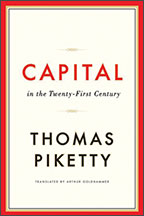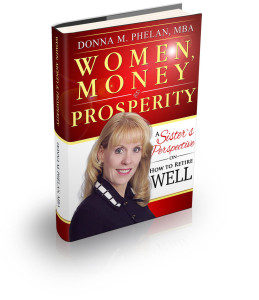Once in a while I read a book and think “That! That is the one that will determine my definitive worldview on a subject.”
This happened when I read Paul Kennedy’s The Rise and Fall of the Great Powers twenty-five years ago, and nothing has shaken my belief in Kennedy’s thesis.[1]
Thomas Piketty’s Capital in the Twenty-First Century is another such book.
One of Piketty’s main goals is to understand the conditions under which concentrated wealth can emerge, persist, vanish, and perhaps reappear.
Piketty’s unique offering, I think, it that he (along with colleagues) built the most complete, historical, transnational data-set on wealth distribution. Specifically, he allows us to compare three centuries of wealth data in France and the UK. He also built the most complete data sets on wealth in Germany, Italy, Scandinavian countries, Japan, and the United States.
Through that longitudinal data we get to see what has changed over the centuries, and where we stand today, compared to the past. We also get to see how the United States stacks up against other wealthy countries.
I’m late to the party in reviewing Piketty’s book – published in 2014 – but I think it doesn’t matter. He’s got centuries of data behind him and the book has a long shelf-life ahead of it.
All inequality discussions are political
Even engaging in a discussion about inequality involves political and normative choices. What we choose to measure, for example, has a great effect on what conclusions we draw.
Readers of Piketty’s work, naturally, come armed to the fight with political agendas. I know I do, and you do too. I happen to think inequality is a defining problem of our time. Others may not agree. ‘How much does inequality matter’ is a deeply political question in and of itself.
Piketty offers a great example of this, when he cites governmental measures of inequality. Traditionally, OECD governments present the ratio between the 90th (top) percentile of income and the 10th (bottom) percentile of income as a proxy for income inequality. Problematically, Piketty points out, this so-called P90/P10 ratio completely ignores the vast concentration of wealth within the top 1% of many countries. The bottom 9% portion of the top 10% in the United States, for example, look like pikers compared to the top 1%, a fact that the P90/P10 ratio tends to hide.
Additionally, the ratio will not indicate what portion of national income the top 10% earns, whether it’s 20% as in the case of Scandinavian Europe in the 1980s, 50% as in the case of the contemporary United States, or 90% in the Belle Epoque era of Britain and France preceding World War I. By choosing to present the P90/P10 ratio, governments choose the ‘chaste veil of official publications,’ a set of data that obscures as much as it enlightens.
War as Equalizer
The devastating wars of the 20th Century destroyed so much concentrated wealth in Britain and France (in addition to Germany and Japan, obviously) that they literally upended the social order. Piketty’s data shows how wealth concentration with the Top 10% and 1% in these countries plummeted in the first half of the 20th Century.
Wealth inequality stayed relatively tame in the decades following World War II, before ticking upward in the 1980s and beyond. An easy explanation for renewed wealth concentration may be changing tax rates, especially following the Reagan & Thatcher revolutions in the Anglo American countries.
Austen & Trollope & an Economist’s style
I have long looked to Jane Austen and Anthony Trollope as sources of information on the meaning and use of wealth, so I was pleased to see Piketty do the same.[2]

Outside of these 19th Century literary references, Piketty does not rely on metaphors, popular writing, or anecdote. He’s an economist, primarily focused on his data and formulas to explain wealth creation. Like a serious economist, he takes great pains to explain his data collection methods and to circumscribe his conclusions. This makes for drier writing, but high credibility.
The Piketty thesis, in a thumbnail sketch
Piketty has a math-based worldview on how wealth becomes concentrated, and how it may inevitably lead to inequality in the future. I’ll attempt to concisely describe it here, so that you may mention it casually and sophisticatedly at your next cocktail party to impress your friends. You are welcome.
In the first section of the book, he builds the case that the proportion of national income that goes to ‘labor’ (what people get paid to do in exchange for the application of their time and talents) versus what goes to ‘capital’ (financial returns that accrue to an accumulated stock of wealth) is a key set of numbers to study in a national economy.
A key number for measuring this is what he calls the national “capital/income ratio” – which measures the stock of accumulated wealth of a country compared to the flow of total national income in any given year.
Typically we might see that the national wealth in a developed country is five or six times greater than the country’s income.
This ratio allows Piketty to measure – over time and across countries – the amount of money that ‘capital’ earns each year versus what ‘labor’ earns each year.
A household analogy for the capital/income ratio
To break that down into household terms and in numbers that our brains can handle, we might say that the capital income ratio of my household could be five if, for example, I boasted of a personal net worth of $500,000 and an annual income of $100,000. I mention the household analogy to illustrate the capital/income ratio as just a way of comparing the fixed accumulated store of wealth with a flow of annual income. Piketty focuses on measuring this number for countries over time, counting the entire national ‘store of wealth’ and the entire national ‘income.’
Second number: % annual return on capital
The reason why the national capital/income ratio matters is that it allows Piketty, and us, to see how much of national income is earned by ‘labor’ versus how much is earned by ‘capital.’ To do this, we need to know what the overall annual ‘rate of return’ on capital is in any national economy. This rate of return is just like how it sounds: If I invest $100,000 for example, do I make 2% on my money, or 6%, or 15%? An individual’s return on investment will depend on the particular investment of course – a bank CD vs. a bond vs. a stock vs. a rental property vs. an angel investment in a startup – to cite a few well-known possible investments. That aggregate national ‘return on investment’ will be the average of all these investments across millions of households and firms.
We might find, and Piketty does, that the average national return on capital often fluctuates in the 4 to 5% range over time.
Certainly Austen and Trollope generally assumed a 5% return on capital. A gentleman landowner who could count on 5,000 pounds per year in income might have been able to value his holdings – although voluntary land-sales were all but forbidden back then – at around 100,000 pounds.
Putting them together – income from capital
A fundamental math formula underpinning Piketty’s book is that the capital income ratio, multiplied by the return on capital, tells us what the overall proportion of income derived from capital is in a national economy. Money either comes from working (labor) or from investing (capital) and it helps us to be able to calculate what portion comes from capital.
Piketty, and we, care about this because it’s the beginning for understanding how wealth grows on wealth and how, possibly, an increasing rate of wealth inequality may in certain circumstances acquire a sort of mathematical inevitability.[3]
To return to a household analogy for a moment – which may help explain what Piketty measures at the national level – we could say again that I have a capital/income ratio of five. That’s based on my presumed $500,000 household net worth and $100,000 annual income (and $500K/$100K is five).
We could then assume that my return on capital (picture my $500K invested in ‘capital stock’ although in reality it might be entirely tied up in my house, but whatever) as 5%. When we multiply 5 fives 5% we get 25%, which represents the ‘annual income derived from capital’ of my household for example.
That annual income derived from capital – at the national level – is what Piketty takes great pains to build historical data around, and to track through time and across countries. We can see from the first math formula that the capital/income ratio determines to a great extent how much of national income will go to holders of capital (in simpler terms, holders of wealth. In simplest terms, how much goes to capitalists rather than workers.)
Piketty tracks the decline in ‘annual income derived from capital’ from the early Twentieth century through World Wars One and Two, but then the steady increase in the annual income derived from capital since the 1950s, as a way to understand changes throughout the last century.
A second math formula
Upon this foundation, Piketty introduces a second math formula. The capital/income ratio will tend to converge toward, over the long run, the ratio of the national savings rate divided by the growth rate of the economy.
A country with a high savings rate will tend, over time, to have a higher capital/income ratio. A country with a low growth rate (because the growth-rate number is in the denominator of the formula) will tend to also have a high capital/income ratio. Both of these situations we might expect will tend to exasperate inequality, as more of a nation’s wealth goes to capital, rather than labor.
By contrast, we would expect high growth rates in the economy over time to lower the capital/income ratio, and over time to lower the percent of income that goes to capital, rather than labor. That might correlate over time with lower inequality.
In either case, small changes in the economic growth rate can have great effects on the capital/income ratio over the long run. This second formula’s predictive capacity, Piketty clarifies, only works over the long run, possibly over decades. Nevertheless, he argues that its effects are constant and unavoidable.
Viewing the future
From a predictive perspective, Piketty would point to the savings rate, the economic growth rate, and the return on capital as the key measures of whether inequality will tend to increase or decrease in a national economy over time. Lower savings rates should lead to higher equality of wealth. Lower returns on capital should also leader to higher equality. But perhaps the biggest determinant of future equality is the growth rate of the economy.
And to simplify 600 pages of complex economic thought: Looking forward the slower secular growth in the economy of developed countries may inevitably doom these economies to increasing rates of wealth inequality.
A further summary of his data: The United States and Britain and France continue to move in a trend – begun in earnest in the 1980s – toward wealth concentration that will resemble the Belle Epoque of 19th Century Britain and France.
When we see the trends, it’s not hard to become alarmed about increasing concentration of wealth forming a sort of permanent aristocracy over our nominal democracies. Piketty urges us to note the data, note the trends, and try to understand the dangers to capitalism and democracy in the long run.
Policy Recommendations
Merely studying inequality is a political and moral choice, but making policy recommendations is obviously even more so. Here is where Piketty’s critics have mostly directed their fire.
Although I love his data and analysis, I am less certain that I will adopt Piketty’s prescriptive worldview on policies.
Piketty favors a progressive annual tax on large fortunes, as a way to combat the inevitability of wealth concentration. To the extent that would involve an estate tax, I am on board. The annual tax on wealth is obviously a further step altogether, since it would occur once a year. I can easily imagine the steps wealthy households would immediately take to avoid this tax, but Piketty nevertheless makes the case.
He also proposes a kind of global tax on capital, which as Piketty readily admits, is hard to imagine becoming a reality right now, both mechanically and politically. Banking coordination and reporting would be a crucial first step. This seems a long way off.
Piketty also favors an increased marginal income tax rate – possibly as high as 80% – on the highest earners in the United States. Although tax revenue from such a high rate on a small number of earners would be minimal, Piketty makes the case that the step would go some way toward reducing the concentration of income-capture by a small cohort of super managers, probably by voluntary compensation policy changes by large firms.
In each of these tax proposals Piketty seeks not to generate much revenue or replace existing tax regimes, but rather to regulate capitalism itself. If capitalism tends toward oligarchic concentrations of wealth – as the first ¾ of the book argues – his goal is to preserve the good of capitalism (efficient allocation of resources, high productivity gains) while mitigating the effects of the bad.
Capital isn’t the last word on these issues, but a key starting point for a discussion on the state of things.
Please see related posts:
Video – Inequality in America by the Wall Street Journal
Interactive Infographic on Inequality by Zip-code in the Washington Post
All Bankers Anonymous Book Reviews in One Place
[1] My summary of Kennedy: First, great powers become great based on their economic strengths. Second, great powers subsequently take on imperial obligations, which require increasingly larger military expenditures. Third, great powers sink under the cost of their military obligations. Like clockwork! And it doesn’t bode well for the current hegemon, with a military budget bigger than the next seven biggest militaries, combined.
[2] He also references the novels of Honore de Balzac, who I have not yet read. But I will someday.
[3] Unless counteracted by policies – like taxes – or exogenous events – like wars. Describing these counterbalancing forces take up a significant portion of the book.
Post read (520) times.




